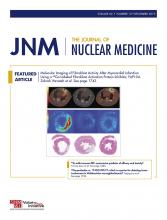TO THE EDITOR: In prostate-cancer patients investigated with 18F‐DCFPyL, a second-generation 18F‐labeled prostate-specific membrane antigen ligand, Jansen et al. have recently validated the image-based tumor‐to‐blood ratio (TBR) as an optimal trade‐off between a reliable surrogate for the net influx rate of the tracer versus simplicity of its assessment (1). The image‐based TBR (blood-mL.tumor-mL−1) can be obtained from any standard whole‐body acquisition as the mean tumor–activity concentration (CT(t); kBq.mL−1) to the time-matched blood–activity concentration (Cp(t); kBq.mL−1) within the ascending aorta. A high correlation coefficient was found between TBR and net-influx-rate constant (Ki; mL. min−1.mL−1) obtained from a reversible 2-tissue-compartment model, whereas the SUV, normalized either to body weight or lean-body mass, showed a poor SUV-Ki correlation (R2 = 0.96 vs. 0.47 and 0.60, respectively; Figure 3 and Table 3 in Jansen et al. (1)).
We believe that the comparison between either whole-blood or image‐based TBR proposed by Jansen et al. and Patlak’s graphical analysis may be fruitful because the former is actually the y-axis of the latter. For t > t* and irreversible trapping, Patlak’s basic equation is indeed: TBR(t) = CT(t)/Cp(t) = Ki × AUC(t)/Cp(t) + Vb (2). AUC(t) is the time integral of Cp(t) and Vb the fraction of free 18F‐DCFPyL in blood and interstitial volume (mL.mL−1). The ratio AUC(t)/Cp(t) is the so-called stretched time (ts; min), and then writing TBR(t) = Ki × ts + Vb leads to further comment on Figure 3B by Jansen et al. that shows TBR versus Ki (1). The linear slope of Figure 3B (R2 = 0.96) is actually an average value of ts that is specific to Jansen et al.’s study. To support this assertion, blood data can be extracted from Figure 1 (using the WebPlotDigitizer software) to calculate AUC from trapezoidal integration and, hence, to calculate ts. Because image‐based TBR was assessed by Jansen et al. at 105–110 min after injection, when t is 107.5 min, ts is then estimated to be 204 min, which is consistent with the 222-min slope for the TBR-Ki correlation reported in Table 3 (1). Thus, such a crucial role of ts in the TBR-Ki correlation and, hence, that of real time t, stresses Jansen et al.’s recommendation for harmonizing injection-acquisition time delay, scanning direction, and whole‐body scan duration, to reliably compare TBRs between centers. Furthermore, the authors acknowledged that TBR repeatability should be investigated for treatment-response assessment. We suggest that TBR repeatability should take into account repeatability of both tumor- and blood-activity concentration because TBR(t) = CT(t)/Cp(t) (= SUVtumor/SUVblood), as demonstrated with SUV in lung cancer patients investigated with 18F-FDG (3). Despite this increased repeatability percentage, blood normalization involved in the TBR makes it a much better surrogate for Ki than the SUV, because the latter is significantly affected by the difference in the blood–activity concentration between patients, depending on the total tumor burden, as illustrated in Figure 4 in Jansen et al. (1,4). This SUV feature involving TBR may be simply summarized as: SUVtumor(t) = TBR(t) × SUVblood(t) ∝ TBR(t) × Cp(t). Finally, let us note that, because of decay correction, the SUV apparently rises during the first 2 h after injection (assuming irreversible trapping), whereas the TBR actually rises with time (Fig. 3A), furthermore justifying Jansen et al.’s recommendation (1).
In conclusion, we are convinced that the image-based TBR can reliably assess 18F‐DCFPyL uptake in prostate cancer metastases, thus opening up possible tumor characterization and treatment-response assessment. We suggest that the TBR may be considered a simplified Patlak’s analysis that is adapted to daily clinical practice (i.e., to standard whole‐body acquisition without the need for invasive blood sampling). In this connection, we suggest that reporting the correlation between TBR and Patlak’s Ki might be of interest.
Footnotes
Published online Aug. 26, 2019.
- © 2019 by the Society of Nuclear Medicine and Molecular Imaging.







